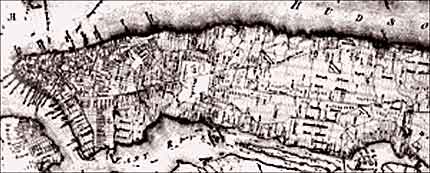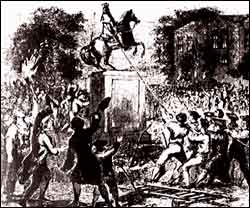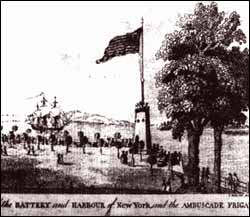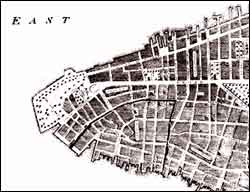The Oldest Parks (1686-1811)
1686
On April 27, 1686, Governor Thomas Dongan granted the Dongan Charter of the City of New York. Part of this early city charter officially put all "waste, vacant, unpatented and unappropriated lands" for the first time in municipal care, under the jurisdiction of the Common Council. These "unappropriated lands" included the outdoor marketplaces and public commons that later became the first city parks. Bowling Green Park was a parade ground and marketplace at the foot of Broadway in 1686. The Battery, at the southern tip of Manhattan, was an open area reserved for the batteries of cannon that later gave Battery Park its name. City Hall Park was a public commons, known as the "Vlackte" or "Flats" in the 17th century, that was used for executions and the burial of paupers and slaves. The city's ownership of all these parks is traced back to the Dongan Charter.
1733
Bowling Green Park, the first official park in New York, was established and named by a resolution of the Common Council on March 12, 1733. It was leased at an annual rent of one peppercorn to John Chambers, Peter Bayard, and Peter Jay, who were responsible for improving the park with grass, trees, and a wooden fence "for the Beauty and Ornament of the Said Street as well as for the Recreation & Delight of the Inhabitants of this City."
1734
In 1734 the Common Council restricted the future development of the Battery when it resolved that, in order to keep the locations of harbor defenses clear, "no manner of Houses or Other Edifices whatever" should be built along the shore from what is present day State Street to Battery Place.
1736
1736 marked the beginning of the construction of public buildings in the "Fields" or "Commons," as City Hall Park was now known. The City's first Almshouse was built around the site of City Hall in this year.
1770
A gilded lead statue of George III, commissioned by grateful New York City merchants after the repeal of the Stamp Act, was the first statue in a city park when it was erected in the center of Bowling Green Park in 1770. In 1771, a wrought iron fence was erected around the irregular oval of the Bowling Green to protect the park and its royal monument. The fence survives to this day and is a designated New York City Landmark.
1776
The July 9, 1776 reading of the Declaration of Independence in "the Fields," or City Hall Park, incited a lively demonstration of support. A crowd proceeded down Broadway to Bowling Green Park and toppled the statue of George III. They then hacked it to pieces to be recast as musket balls. That autumn the Battle of Long Island was fought on the ground which later became Prospect Park, and in northern Manhattan battles were fought in the areas that became St. Nicholas, Fort Washington, Fort Tryon, Inwood Hill and Bennett Parks.
1783
The British evacuated New York on November 25, 1783, thereafter known as Evacuation Day. The occasion was celebrated at the Battery, where Washington reviewed his troops. During the occupation of New York (which began in 1776) thousands of Americans had died in British prison ships moored at Wallabout Bay and other locations. In 1908 the Prison Ship Martyrs' Monument was erected in Fort Greene Park in Brooklyn over a crypt containing the recovered remains of 11,000 patriots who died on the prison ships.
1784
New York was made the first capital of New York State and of the United States in 1784, a distinction which stimulated improvements to the city's parks, especially Battery Park. Trees were planted along its sea wall, fences built, and the shoreline extended through landfill. Open access to the waterfront and magnificent harbor views made the Battery New Yorkers' favorite spot for an afternoon stroll or an evening promenade. George Washington mentions frequent walks "round the Battery" in the diaries he kept during his residence in New York at this time.
1797
Property along Minetta Brook in Greenwich Village was acquired by the city in 1797 for a potter's field. In 1823 the cemetery was closed, and the area was declared a public square known as Washington Paradeground, or Washington Square. Duane Street Park, at Duane and Hudson Streets, was also acquired in 1797. Trinity Church sold the triangle of land to the city for five dollars, on the condition that it be fenced and landscaped "as promotive of health and recreation." It was the first park purchased by the city specifically for that purpose.
1803
The cornerstone of City Hall was laid in City Hall Park in 1803. City Hall Park had also been improved with trees and grass after 1784, and by 1803 this popular commons and gathering place was referred to as "The Park."
1807
On April 3, 1807 the Common Council appointed three commissioners, Gouverneur Morris, Simeon De Witt, and John Rutherford, to lay out streets and public squares in Manhattan in a manner "most conducive to the public good." The commissioners devised a rectangular grid of avenues and streets which became the most familiar topographic characteristic of the city above Canal Street. Known as the Commissioners' Plan, or Randel Survey (John Randel, Jr. surveyed and drew the plan.), it was published in 1811.

"Commissioners' Plan" of 1811
The familiar grid plan for Manhattan, first published in 1811, designated little open space for New York. By the 1840s the neglect of an adequate city plan threatened to make the crowded city uninhabitable. Drastic solutions were called for, and in 1853 the city began proceedings to acquire 770 acres (later expanded to 840) out of the heart of the 1811 grid plan for the creation of Central Park.
(Collection of the New-York Historical Society)


